

Neuropsychologia. Cognition. Neuron. Science Direct - Auditory Processing Disorder. A dual-route perspective on poor reading in a regular orthography: An fMRI study. A systematic review of controlled trials on visual stress using Intuitive Overlays or the Intuitive Colorimeter. Auditory Neuropathy / Auditory Dyssynchrony in children with Cochlear Implants - ScienceDirect. The approach for habilitating and rehabilitating patients with auditory neuropathy/auditory dys-synchrony (AN/AD) has raised diverging questions and opinions, because these individuals continue to be placed in the special cases group for cochlear implants.

The term auditory neuropathy has been used generically to name discrepancies between the cochlear and neural functions of the auditory system. AN/AD has been described in the literature as a change in neural synchronism whereby the function of outer hair cells is preserved while afferent neural transmission is compromised. However, to this date the exact injury site has not been demonstrated by current methods in clinical practice. AN/AD can significantly affect speech understanding and production. Thus, adequate habilitation and rehabilitation is needed especially in children, who go through critical hearing and language development periods. Brain Imaging Findings in Dyslexia. <div pearltreesdevid="PTD238" role="alert" class="alert-message-container"><div pearltreesdevid="PTD239" aria-hidden="true" class="alert-message-body"><span pearltreesdevid="PTD240" style="display: inline-block;" class="Icon IconAlert"><svg pearltreesDevId="PTD241" style="width: 100%; height: 100%;" width="24" height="24" focusable="false" tabindex="-1" fill="currentColor"><path pearltreesDevId="PTD242" fill="#f80" d="M11.84 4.63c-.77.05-1.42.6-1.74 1.27-1.95 3.38-3.9 6.75-5.85 10.13-.48.83-.24 1.99.53 2.56.7.6 1.66.36 2.5.41 3.63 0 7.27.01 10.9-.01 1.13-.07 2.04-1.28 1.76-2.39-.1-.58-.56-1.02-.81-1.55-1.85-3.21-3.69-6.43-5.55-9.64-.42-.52-1.06-.83-1.74-.79z"></path><path pearltreesDevId="PTD243" d="M11 8h2v5h-2zM11 14h2v2h-2z"></path></svg></span><!

-- react-text: 50 -->JavaScript is disabled on your browser. Please enable JavaScript to use all the features on this page. <! -- /react-text --></div></div> References. Children with developmental dyslexia show a left visual “minineglect” Open Archive Abstract We investigated the performance of children with developmental dyslexia on a visual line bisection task.
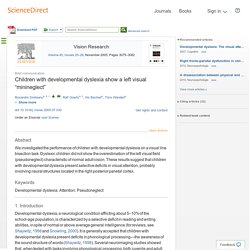
Dyslexic children did not show the overestimation of the left visual field (pseudoneglect) characteristic of normal adult vision. These results suggest that children with developmental dyslexia present selective deficits in visual attention, probably involving neural structures located in the right posterior parietal cortex. Keywords. Children with dyslexia lack multiple specializations along the visual word-form (VWF) system. A MR-Center, University Children's Hospital, University of Zurich, Zurich, Switzerlandb Department of Child and Adolescent Psychiatry, University of Zurich, Zurich, Switzerlandc Sackler Institute for Developmental Psychobiology, Weill Medical College of Cornell University, New York, USAd Department of Neurology, Technische Universität München, (81675) München, Germanye Agora Center, University of Jyväskylä, Jyväskylä, Finlandf Department of Psychology and Center for Neurocognitive Research, University of Salzburg, Salzburg, Austriag Department of Neurology and Center for Neurocognitive Research, Christian Doppler Clinic, Paracelsus Private Medical University, Salzburg, Austriah Center for Integrative Human Physiology, University of Zurich, Zurich, Switzerlandi Department of Child and Adolescent Psychiatry and Psychotherapy, Central Institute of Mental Health, Mannheim, Germany Received 11 February 2009, Revised 27 April 2009, Accepted 6 May 2009, Available online 14 May 2009 Check access.
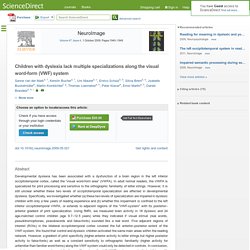
Cultural Confusions Show that Facial Expressions Are Not Universal: Current Biology. Figure 1 Fixation Distributions (A) Fixation distributions for each observer group collapsed across race of face and seven expression categories (see Figure S2 for fixation distributions for each condition separately).

Color-coded distributions represent the density of fixations across face regions, with red showing the most densely fixated regions. Note that for East Asian (EA) observers, fixations are biased toward the upper part of the face as compared to Western Caucasian (WC) observers, where fixations are more evenly distributed across the face, including the mouth. (B) Fixation distributions for “surprise,” “fear,” “disgust,” and “anger.” Figure 2 Fixation Sequences for “Surprise,” “Fear,” “Anger,” and “Disgust” Developmental dyslexia is characterized by the co-existence of visuospatial and phonological disorders in Chinese children. Open Archive Summary Developmental dyslexia is a neurological condition that is characterized by severe impairment in reading skill acquisition in people with adequate intelligence and typical schooling 1, 2 and 3.
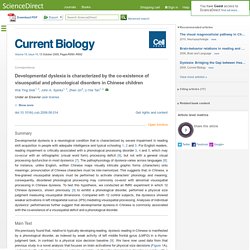
For English readers, reading impairment is critically associated with a phonological processing disorder 3, 4 and 5, which may co-occur with an orthographic (visual word form) processing deficit [6], but not with a general visual processing dysfunction in most dyslexics [7]. The pathophysiology of dyslexia varies across languages [8]: for instance, unlike English, written Chinese maps visually intricate graphic forms (characters) onto meanings; pronunciation of Chinese characters must be rote memorized. Disorders of higher visual processing. Volume 102, 2011, Pages 223–261 Neuro-ophthalmology Edited By Christopher Kennard and R.
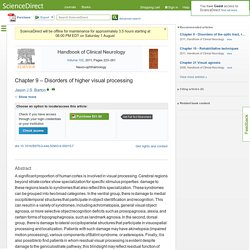
John Leigh Jason J.S. Do people use language production to make predictions during comprehension? Opinion 1 Department of Psychology, University of Edinburgh, 7 George Square, Edinburgh EH8 9JZ, UK2 Department of Psychology, University of Glasgow, 58 Hillhead Street, Glasgow G12 8QB, UK Available online 24 January 2007 Choose an option to locate/access this article: Check if you have access through your login credentials or your institution Check access.
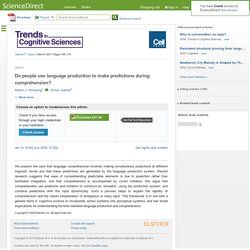
Exploring the role of auditory analysis in atypical compared to typical language development. Open Access Highlights Auditory and language skills were tested in 28 11-year olds with dyslexic traits.

Explosive, oppositional, and aggressive behavior in children with autism compared to other clinical disorders and typical children. Department of Psychiatry, Penn State College of Medicine, Hershey, PA, United States Received 16 August 2011, Accepted 17 August 2011, Available online 21 September 2011 Choose an option to locate/access this article: Check if you have access through your login credentials or your institution Check access.

Increased variability of stimulus-driven cortical responses is associated with genetic variability in children with and without dyslexia. JavaScript is disabled on your browser. Please enable JavaScript to use all the features on this page. Highlights Quantified variability in evoked neural responses of children with and without dyslexia. A subset of children with dyslexia had significantly higher variability in cortex. Higher variability observed in auditory and visual domains in multiple reading network nodes.
Integrating MRI brain imaging studies of pre-reading children with current theories of developmental dyslexia: a review and quantitative meta-analysis. <div class="msgBox" style="margin-top:10px;"><span class="errMsg"><div>JavaScript is disabled on your browser. Please enable JavaScript to use all the features on this page. This page uses JavaScript to progressively load the article content as a user scrolls. Click the View full text link to bypass dynamically loaded article content. Learning and Cognitive Disorders: Multidiscipline Treatment Approaches Review Article. ScienceDirect is phasing out support for older versions of Internet Explorer on Jan 12, 2016.
For the best product experience, we recommend you upgrade to a newer version of IE or use a different browser: Firefox or Chrome. For additional information please see the ScienceDirect Blog page. Close ScienceDirect is phasing out support for older versions of Internet Explorer on Jan 12, 2016. For the best product experience, we recommend you upgrade to a newer version of IE or use a different browser: Firefox or Chrome. Metabolic and mitochondrial disorders associated with epilepsy in children with autism spectrum disorder. Highlights •Many children with ASD have underlying metabolic conditions. •Metabolic disorders are also commonly associated with epilepsy. •Treating metabolic disorders may optimize seizure management. Abstract Autism spectrum disorder (ASD) affects a significant number of individuals in the United States, with the prevalence continuing to grow.
This article is part of a Special Issue entitled “Autism and Epilepsy”. Neural bases of childhood speech disorders: Lateralization and plasticity for speech functions during development. Review a Developmental Cognitive Neuroscience Unit, UCL Institute of Child Health, 30 Guilford Street, London WC1N 1EH, UKb Murdoch Childrens Research Institute, Melbourne, Australiac Royal Childrens Hospital, Melbourne, Australiad Department of Paediatrics, University of Melbourne, Melbourne, Australia Received 3 June 2011, Revised 7 July 2011, Accepted 23 July 2011, Available online 30 July 2011 Choose an option to locate/access this article: Check if you have access through your login credentials or your institution Check access. Neural changes underlying the development of episodic memory during middle childhood.
Potential hormonal mechanisms of Attention-Deficit/Hyperactivity Disorder and Major Depressive Disorder: A new perspective. Review. Procedural learning is impaired in dyslexia: Evidence from a meta-analysis of serial reaction time studies. Reading skill related to left ventral occipitotemporal cortex during a phonological awareness task in 5–6-year old children. JavaScript is disabled on your browser. Please enable JavaScript to use all the features on this page. Abstract. Sequential or simultaneous visual processing deficit in developmental dyslexia? Open Archive Abstract. The two-component model of memory development, and its potential implications for educational settings. Abstract We recently introduced a two-component model of the mechanisms underlying age differences in memory functioning across the lifespan. According to this model, memory performance is based on associative and strategic components. The associative component is relatively mature by middle childhood, whereas the strategic component shows a maturational lag and continues to develop until young adulthood.
Focusing on work from our own lab, we review studies from the domains of episodic and working memory informed by this model, and discuss their potential implications for educational settings. The episodic memory studies uncover the latent potential of the associative component in childhood by documenting children's ability to greatly improve their memory performance following mnemonic instruction and training. Highlights Keywords. Two types of phonological dyslexia – A contemporary review. Review. Using in vivo probabilistic tractography to reveal two segregated dorsal ‘language-cognitive’ pathways in the human brain. Vestibular insights into cognition and psychiatry - ScienceDirect. The second section of this literature review addresses what is currently known about cognitive and psychiatric symptoms associated with vestibular dysfunction. Why is the processing of global motion impaired in adults with developmental dyslexia?
Open Access Highlights Readers with dyslexia do not have a selective deficit of global motion perception. The visual impairment in dyslexia is a difficulty processing temporal information. Global motion and form thresholds are significantly positively correlated. Gender and non-verbal IQ predict performance on random-dot global motion tasks.